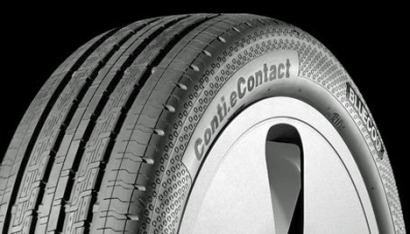
The Conti.eContact, which is described as the first tyres in the world especially developed for electric and hybrid vehicles, was developed in collaboration with Europe’s largest car manufacturers and aims to meet the demands of the predicted 2.8 million electric vehicle owners expected to exist in 2020.
With the Conti.eContact, Continental has a new class of tires at the starting line, tires that have been developed for the special requirements of electric vehicles (EVs) and hybrid cars. In developing such tires, a particular achievement of the development engineers was in considerably lowering the rolling resistance in order to increase the travel range of electric vehicles and to facilitate longer operation with the electric motor in hybrid vehicles.
Tires for EVs must fulfil different requirements than tires for conventional vehicles. For instance, they must have substantially lower rolling resistance and a lower noise level, while the high-speed requirements are lower. In order to maintain high standards for directional stability and handling, different tread variants are produced in some cases, also for use on the front and rear axle. The tire sizes also differ depending on the type of vehicle. For example, smaller, narrower dimensions are required for light urban vehicles, while EVs with more volume use tires for the 20-inch rims.
The rolling resistance is 30% lower than with conventional tires. Continental engineers achieved this reduction by using a completely unusual tire dimension. With the tire size for the 195/55 R 20 test setup, the Conti.eContact has become very large and narrow in appearance.
Thanks to the larger tire diameter, deformation of the tire is reduced when entering the contact patch, thus lowering rolling resistance considerably. This also means that the same load bearing capacity can be achieved as for conventional tires. In addition, the side wall of the tire was designed in such a way that less energy is lost when the tire deflects and rebounds, and the tire weight was further reduced.
These measures also lower the rolling resistance. With its combination of four longitudinal grooves, high number of sipes, the absence of traverse grooves and the rigidity of the tread ribs, the tread has been optimized for low rolling resistance and low noise emission. In this way, precise handling properties and safe braking distances on wet surfaces were achieved as well. The very flat tire contour prevents the tire’s belt elements from moving more, thus further reducing rolling resistance.
The side wall has also been designed for low energy consumption. Here, the developers did not use the usual edges and design elements in order to keep air resistance as low as possible. These properties make the Conti.eContact an ideal tire for e-cars and hybrids.
By greatly reducing rolling resistance, Continental aims to cut the energy required by EVs and thus increase the operational radius of this new type of vehicle. The extended range this makes possible will significantly increase end-consumer acceptance of these vehicles, while at the same time reducing the energy used per 100 km and the time required to charge the batteries.
“Continental regards the emerging trend toward electromobility as one of the key trends in the future of the automotive industry. As one of the world’s leading suppliers, the corporation wants to actively shape this by developing not just tires, but also battery systems, electrical drive systems, regenerative braking systems and numerous interior applications,” said the company in a press statement.
For additional information:

